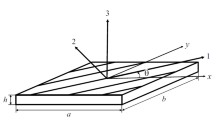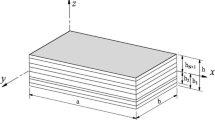A simple four-node isoparametric finite element with five degrees of freedom, based on Reddy’s third-order shear deformation theory, is elaborated and used in a model for analizing the bending of laminated plates. The results obtained are compared with solutions given by the three-dimensional elasticity and other theories.



Similar content being viewed by others
References
S. K. Gill, M. Gupta, and P. Satsangi, “Prediction of cutting forces in machining of unidirectional glass-fiber-reinforced plastic composites,” Frontiers of Mechanical Engineering, 8, No. 2. 187-200 (2013).
A. Mouritz et al., “Review of advanced composite structures for naval ships and submarines,” Compos. Struct., 53, No. 1, 21-42 (2001).
A. Tati and A. Abibsi, “Un element fini pour la flexion et le flambage des plaques minces stratifiees en materiaux composites,” Revue Des Composites Et Des Materiaux Avances, 17, No. 3, 279–296 (2007).
Y. Zhang and C. Yang, “Recent developments in finite element analysis for laminated composite plates,” Compos. Struct., 88, No. 1, 147-157 (2009).
R. Mindlin, “Influence of rotary inertia and shear in flexural motions of isotropic elastic plates,” J. Appl. Mech., 18, 31-38 (1951).
J. M. Whitney and A. W. Leissa, “Analysis of heterogeneous anisotropic plates,” J. Appl. Mech., 36, No. 2, 261-266 (1969).
J. N. Reddy, Energy and Variational Methods in Applied Mechanics, N. Y., John Wiley, 1984.
E. Reissner, “The effect of transverse shear deformations on the bending of elastic plates,” J. Appl. Mech., 12, A69-A77 (1945).
E. Reissner, “A consistent treatment of transverse shear deformations in laminated anisotropic plates,” AIAA J., 10, No. 5, 716-718 (1972).
J. M. Whitney, “The effect of transverse shear deformation on the bending of laminated plates,” J. Compos. Mater., 3, No. 3, 534-547 (1969).
J. N. Reddy, Mechanics of Laminated Composite Plates and Shells: Theory and Analysis, CRC Press, Boca Raton, FL, Second Edition, 2004.
R. Christensen K. Lo, and E. Wu, “A high-order theory of plate deformation part 1: homogeneous plates,” J. Appl. Mech., 44, No. 7, 663-668 (1977).
S. Mau, “A refined laminated plate theory,” J. Appl. Mech., 40, No. 2, 606-607 (1973).
C.-T. Sun, “Theory of laminated plates,” J. Appl. Mech., 38, No. 1, 231-238 (1971).
J. Whitney and C. Sun, “A higher order theory for extensional motion of laminated composites,” J. of Sound and Vibration, 30, No. 1, 85-97 (1973).
J. N. Reddy, “A refined nonlinear theory of plates with transverse shear deformation,” Int. J. of Solids and Structures, 20, No. 9, 881-896 (1984).
J. N. Reddy, “A simple higher-order theory for laminated composite plates,” J. Appl. Mech., 51, No. 4, 745-752 (1984).
N. N. Khoa and T. I. Thinh, “Finite element analysis of laminated composite plates using high order shear deformation theory,” Vietnam J. of Mechanics, 29, No. 1, 47-57 (2008).
J. L. Batoz and M. B. Tahar, “Evaluation of a new quadrilateral thin plate bending element,” Int. J. for Numerical Methods in Engineering, 18, No. 11, 1655-1677 (1982).
C. H. Thai et al., “Analysis of laminated composite plates using higher-order shear deformation plate theory and nodebased smoothed discrete shear gap method,” Appl. Mathematical Modelling, 36, No. 11, 5657-5677 (2012).
H. Fukunaga, N. Hu, and G. Ren, “FEM modeling of adaptive composite structures using a reduced higher-order plate theory via penalty functions,” Int. J. of Solids and Structures, 38, No. 48,. 8735-8752 (2001).
A. H. Sheikh and A. Chakrabarti, “A new plate bending element based on higher-order shear deformation theory for the analysis of composite plates,” Finite Elements in Analysis and Design, 39, No. 9, 883-903 (2003).
T. Kant and B. Pandya, “A simple finite element formulation of a higher-order theory for unsymmetrically laminated composite plates,” Compos. Struct., 9, No. 3, 215-246 (1988).
L. V. Tran, C. H. Thai, and H. Nguyen-Xuan, “An isogeometric finite element formulation for thermal buckling analysis of functionally graded plates,” Finite Elements in Analysis and Design, 73, 65-76 (2013).
A. J. Ferreira, MATLAB codes for finite element analysis: solids and structures, 157, Springer, 2008,.
J. V. Kouri, Improved Finite Element Analysis of Thick Laminated Composite Plates by the Predictor Corrector Technique and Approximation of C (1) Continuity with a New Least Squares Element, DTIC Document, 1991.
J. Reddy, E. Barbero, and J. Teply, “A plate bending element based on a generalized laminate plate theory,” Int. J. for Numerical Methods in Engineering, 28, No. 10, 2275-2292 (1989).
N. Pagano, “Exact solutions for rectangular bidirectional composites and sandwich plates,” J. Compos. Mater., 4, No. 1, 20-34 (1970).
Z. Wu, R. Chen, and W. Chen, “Refined laminated composite plate element based on global–local higher-order shear deformation theory,” Compos. Struct., 70, No. 2, 135-152 (2005).
N. Pagano and H. J. Hatfield, “Elastic behavior of multilayered bidirectional composites,” AIAA J., 10, No. 7, 931-933 (1972).
Author information
Authors and Affiliations
Corresponding author
Additional information
Russiam translation published in Mekhanika Kompozitnykh Materialov, Vol. 52, No. 2, pp. 367-384, March-April, 2016.
Appendix
Appendix
The matrix of the first-order derivative can be presented as
To obtain the second-order derivatives, the chain rule is successively applied to these relations, resulting in
Rights and permissions
About this article
Cite this article
Belkaid, K., Tati, A. & Boumaraf, R. A Simple Finite Element with Five Degrees of Freedom Based on Reddy’s Third-Order Shear Deformation Theory. Mech Compos Mater 52, 257–270 (2016). https://doi.org/10.1007/s11029-016-9578-z
Received:
Published:
Issue Date:
DOI: https://doi.org/10.1007/s11029-016-9578-z




